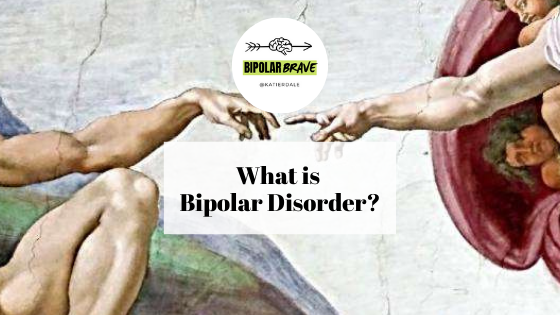Bipolar Disorder is an emotional and mental condition due to a chemical imbalance in the brain.
According to the Diagnostic and Statistical Manual of Mental Disorders (DSM), Bipolar Disorder is “characterized by the occurrence of at least one manic or mixed-manic episode during the patient’s lifetime. Most patients also, at other times, have one or more depressive episodes. In the intervals between these episodes, most patients return to their normal state of well-being. Thus bipolar disorder is a “cyclic” or “periodic” illness, with patients cycling “up” into a manic or mixed-manic episode, then returning to normal, and cycling “down” into a depressive episode from which they likewise eventually more or less recover.”
What is Mania?
Mania is a pole and the part of the bipolar cycle that manifests itself as, “heightened mood (either euphoric or irritable); flight of ideas and pressure of speech; and increased energy, decreased need for sleep, and hyperactivity.”
It’s the up.
It’s when you’re high on life, narrating your every move like the director of a movie.
It’s when you’re full of passion, overdosing on grandiose thoughts of personal achievements and conquests.
It’s when you’re quick and nimble, rapping and freestyling your way through your walk in the park.
It’s quite fascinating, actually. And it’s when you’re paranoid, psychotic, and believing everyone notices you.
What is Bipolar Depression?
Symptoms of the depressed state, “tend to be characterized by psychomotor retardation (slowing of brain and body functions), hyperphagia (overeating), and hypersomnolence (sleepy), and are not uncommonly accompanied by delusions or hallucinations“.
It’s wit’s end.
It’s when you’re critical and stingy.
It’s when you’re down and out, coming to loathe yourself and everyone you come in contact with.
It’s suffering.
Your energy plummets, you want to sleep all the time. You’ve lost all interest and hope in anything. Life is not worth living it seems, in this state of mind.
Bipolar disorder affects one in many ways. Natural tendencies or normal behaviors are affected by the disease as it stems from the mind.
Since our mind is what controls our behaviors and how we live, those with bipolar disorder come to be challenged with every encounter socially, physically, emotionally, spiritually and intellectually.
Every dimension of life (social, physical, emotional, spiritual, intellectual) is intertwined and cannot be separated from the others. Thus, when bipolar disorder comes into play, many natural, logical, and normal functions can be subjected to the disorder and imbalance of the illness.
They can cause mild to severe cases of emotional outbursts, abnormal thought patterns, leading to irrational beliefs and hallucinations, thus leading to unstable and erratic behaviors.
According to the latest bipolar statistics quoted by the Depression and Bipolar Support Alliance (DBSA):
“Bipolar disorder affects approximately 5.7 million adult Americans, or about 2.6% of the U.S. population age 18 and older every year.” (National Institute of Mental Health).
For me, bipolar disorder is under control at this time through medication and numerous sessions of talk therapy. But when I look back on the episodes, both manic and depressed, they were very challenging times that I still remember to the smallest detail.
I remember feelings, moods, faces, places, situations, conversations.
I can laugh and smile now because as hard as it was then, I find it kind of a funny thing to look back and see my outrageous behaviors as comical. Those laughable moments exist, and then there are things I regret deeply and have been saddened by.
These things do happen, but at the same time, they’re never impossible to overcome. My symptoms remain in remission thanks to my medication and the grace of God.
It’s a demon I really hope I never have to fight or encounter again, but if it does come, by God’s grace I will come through. He’s there, faithful and true. That’s why I can call my blog BipolarBrave. Because I know it’s brave to have been burdened and blessed with this disease.
For more information on the disorder, here is where I pulled my research from. And for more information on how to recognize Bipolar Disorder, please check this article from psychiatry.org out.

What do you think?